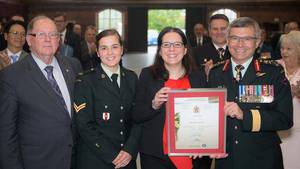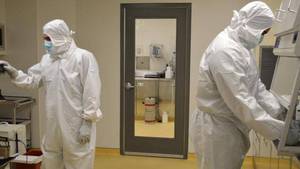Using a wheelchair isn’t as easy as pushing the wheels and setting off into the open world. There are obstacles, such as gravel, grass and uneven sidewalks, that wheelchair users require a little extra training and practice to master.
Dr. R. Lee Kirby at the QEII’s Nova Scotia Rehabilitation Centre, has focused his research on assistive technology and rehabilitation to understand the needs of the clients he works with. His research has also resulted in many practical applications, the most tangible of them being the Wheelchair Skills Program (WSP). A partnership between the QEII and Dalhousie University, the WSP trains clinicians, caregivers and wheelchair users in the skills needed to access the world around them.
The WSP is currently comprised of a wheelchair skills questionnaire, a hands-on wheelchair skills test and a wheelchair skills training program. With a training area in the Rehabilitation Centre funded by the QEII Foundation, those going through the program can learn how to properly handle transitioning from one surface to another, going up and down steps of various height, inclined surfaces and more.
Dr. Kirby believes that rehabilitation is more than just addressing a person’s physical impairments; it’s also about using assistive technology to achieve the greatest possible function and participation in society.
“You can only improve a person up to a certain point, after that there’s nothing you can do,” says Dr. Kirby. “Strengthening – yes, improving range of motion – yes, avoiding complications –yes, those are all good. But the most significant benefits that the interdisciplinary rehabilitation team can achieve come from assistive technology and modifying the person’s environment.”
Wheelchair training is only part of the service that the QEII offers. Some patients require a more complex and customized chair, which is where the Specialty Seating & Mobility Service at the Rehabilitation Centre comes in.
Catherine Frazee moved to Nova Scotia in 2010. When she was getting her old wheelchair repaired, talks arose of getting a new chair entirely.
“Getting a new wheelchair is a very stressful, demanding and strenuous process, I was reluctant at first,” says Catherine. “But on the strength of my technician's very enthusiastic recommendation, I felt like I had nothing to lose.”
Catherine has Spinal Muscular Atrophy Type II, which makes it critical to have a custom-fitted wheelchair. Her movements and control of the chair must be centred around using two fingers. She was astounded at how skillfully the Specialty Seating & Mobility Service worked to address her needs.
“My occupational therapist, Carolyn Kelly, understood the particularities of my body type, and was able – almost intuitively – to make all the fine adjustments needed for my comfort and function,” says Catherine. “It didn’t feel experimental, it didn’t feel exploratory; she really worked with me.”
Cher Smith, an occupational therapist, coordinator for the Specialty Seating & Mobility Service at the QEII and a member of the Wheelchair Skills Program team, says the key to successfully working with the client is not focusing on the negatives, but rather how to turn them into positives.
“It’s not about the person’s disability, but more about what people can do,” says Cher. “And it’s our job to facilitate what people can do."
The Specialty Seating & Mobility Service provides custom-fitted seats, back cushions, and any other adjustments that need to be made, such as a wheelchair to be operated via breathing, sight and minimal body movements. The client’s home is also taken into consideration.
“A lot of it is compromise; with every single decision you make on a chair, it has a different impact,” says Cher. While there are a lot of decisions to be made, and minor-but-essential modifications for every chair, the team works to ensure that the clients are happy – something Catherine can attest to.
For Cher, Catherine’s experience isn’t the exception, it’s the rule. The client comes first, as a wheelchair is something that can’t be taken for granted; it’s an essential piece of technology.
“A wheelchair is an enabler,” says Cher. “When done right it allows people to do so many things.”








